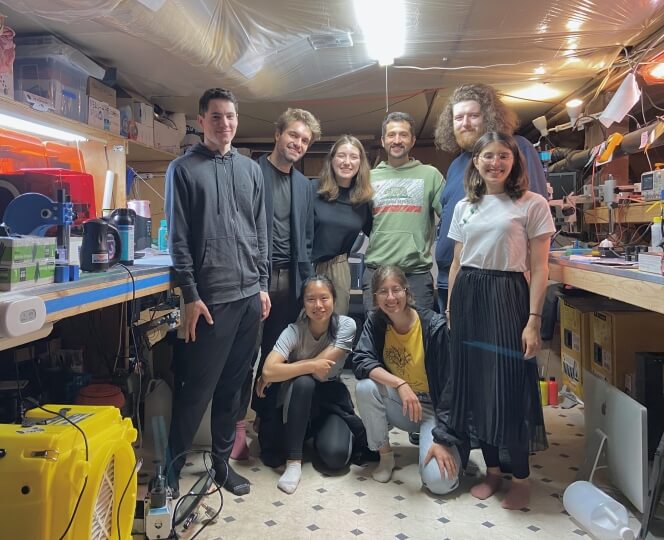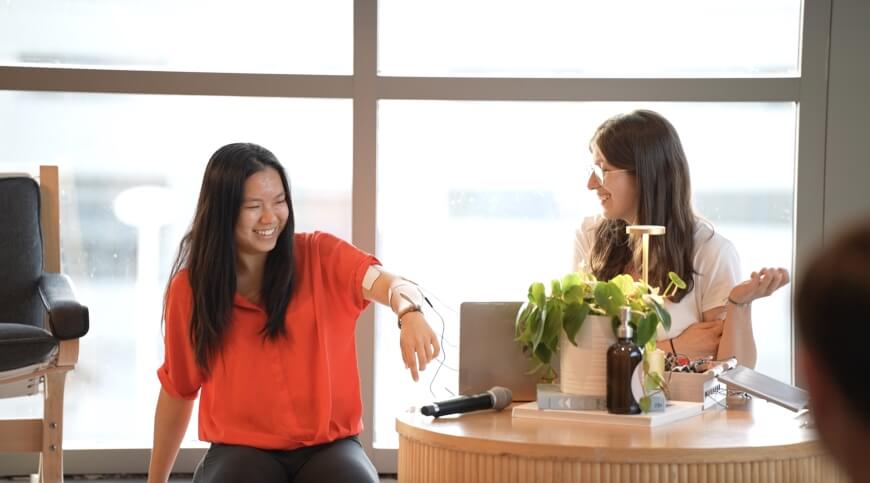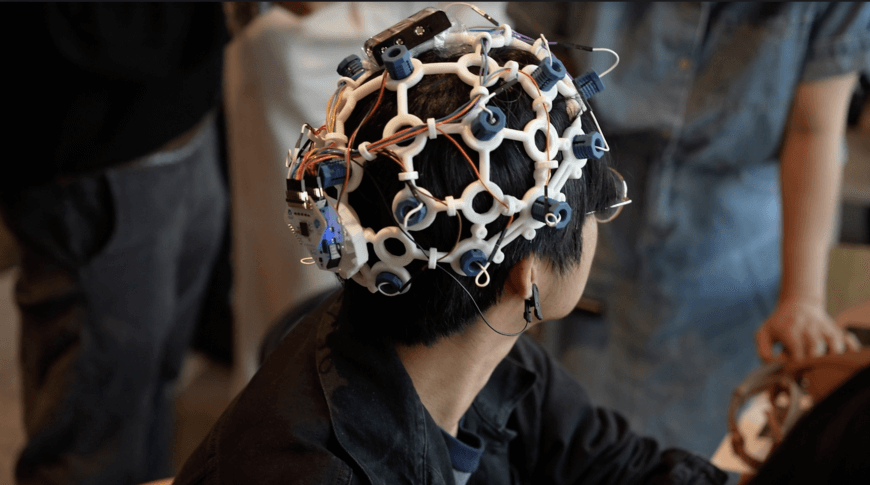News
Augmentation Lab summer residency cohort with mentor Tomás Vega in the Augmental makerspace. (Augmentation Lab)
Could sensing ambient magnetic fields change how we see the world? How would we speak if we could see the physiological effects our words had on others? Would abstract art based on human brain scans shift our understanding of creativity and imagination?
Four students at the Harvard John A. Paulson School of Engineering and Applied Sciences (SEAS) and MIT Media Lab want to answer those questions. Aida Baradari, Alice Cai, Dünya Baradari, and Treyden Chiaravalloti co-founded and run the Augmentation Lab, a student-led organization that uses technology to explore and expand human experience, interaction, and creative expression. Over the past summer, the team organized a 10-week residency in San Francisco in which a mix of eight undergraduate and graduate students and young professionals built projects on the intersection of humanism and machines.
“We had a vision for how technology could be developed differently and how we could improve our relationship to technology,” said Alice Cai, a third-year student pursuing a special concentration in Human Augmentation. “We felt that going into the future, humanity could use more thoughtful development and augmentation technologies that truthfully improve your life. We approached this residency model with the idea of self-experimentation, where you can implement the technologies you’ve built in your own life to experientially understand their effect.”
A typical day in the residency, which took place at a house in San Francisco, mixed technological innovation and philosophical discussion. Residents would often begin working on their projects as soon as they got out of bed, and then spend all day working. The evenings often featured a communal dinner in which residents would discuss existential questions they’d written down and placed in a hat.
We built a makerspace in the living room, where we had 3D printers, oscilloscopes, soldering stations, extended reality equipment, brain computer interface headsets, and other equipment. It was a very unique vibe.
The residency’s final products included mixtures of hardware, software, and storytelling. The Haptic Ring is a sensory augmentation wearable device that vibrates in the presence of magnetic fields, while Enact is an artificial intelligence (AI) web application that guides users in roleplaying for difficult conversations. Emothesia uses an augmented reality headset to display another person’s biological data, such as heart rate or temperature. The Imagination Engine scans brainwaves with an EEG headset, and then feeds the data to a generative AI program to create abstract art. GameChanger aims to help people change by prompting users to engage in Fluxus-inspired experiments in daily life. The Empathy Machine stimulates the wearer’s muscle activity based on someone else’s muscle movements, mimicking a phenomenon called mirror-touch synesthesia.
SEAS students and Augmentation Lab co-founders Alice Cai and Aida Baradari test the Empathy Machine, which stimulates the wearer’s muscle activity based on someone else’s muscle movements. (Augmentation Lab)
“We wanted to develop a broad range of tools with a broad range of applications,” said Treyden Chiaravalloti, who’s pursuing a Master in Design Studies on the Technology track at the Harvard Graduate School of Design. “Technology within the lens of augmentation is something that helps us do something that we haven’t evolved to do. We really tried to think deeply about what we’d like to do better but can’t, and how technology can fill that gap.”
While each of these technologies can meet a specific need, human-centric design is just one motivation behind the Augmentation Lab’s projects. The devices combine human need with the thrill of experimental research, speculative explorations of future societal challenges, and technology as a form of artistic expression.
“We had to investigate our own motivations as developers, whether we’re driven by a pure desire to create, or a commitment to improving some aspect of human experience,” Cai said. “From my perspective, I’m compelled by what I’d use in my own life, but I’m also compelled by more speculative provocations.”
The team began developing the residency last March. They’d already collaborated on several augmentation projects, including a robotic limb they presented at the spring SEAS Design Fair. Not wanting to pursue traditional internships for the summer, they devised the residency. While the timeline was tight, they managed to secure funding and selected technologists Inga Zhuravleva, Jennifer Huang, Aeden Cullen, and Ellery Buntel from close to 200 applicants.
“In our application process, we asked for initial ideas about projects applicants were interested in,” said Dünya Baradari, a Master's student in Bioinformatics at the University of Leipzig and MIT Media Lab. “This was to gauge creativity and how much their interests aligned with ours, as well as their technical backgrounds. We wanted a diverse cohort in terms of experience and skill set, so we had to pass on many talented individuals.”
Aida added, “I was so excited, I dropped the internship I’d had at NASA to get this going.”
A participant tries out the Imagination Engine, which scans brainwaves with an EEG headset, then feeds the data to a generative artificial intelligence program to create abstract art. (Augmentation Lab)
Many members of the Augmentation Lab’s leadership team are currently at Harvard or MIT, including SEAS computer science students Caine Ardayfio and Aryan Naveenso. With the residency now complete, the lab is looking to further grow throughout the school year. They plan to publish essays and op-eds about the future of technology, while also developing new technologies and continuing to gather and encourage interdisciplinary conversation between artists, technologists, policy makers, and beyond.
“We’re seeing this huge development of more accessible augmentation tools, such as more affordable VR headsets and the implementation of artificial intelligence in many applications,” Chiaravalloti. “It seems like a rich, fertile ground for making new projects.”
The Augmentation Lab is associated with the SEAS-affiliated student organization AR/VR Developers, and received support from the Student Experiences unit of the SEAS Teaching and Learning group, as well as the Harvard Grid.
Topics: AI / Machine Learning, Computer Science, Design, Technology
Cutting-edge science delivered direct to your inbox.
Join the Harvard SEAS mailing list.
Press Contact
Matt Goisman | mgoisman@g.harvard.edu





